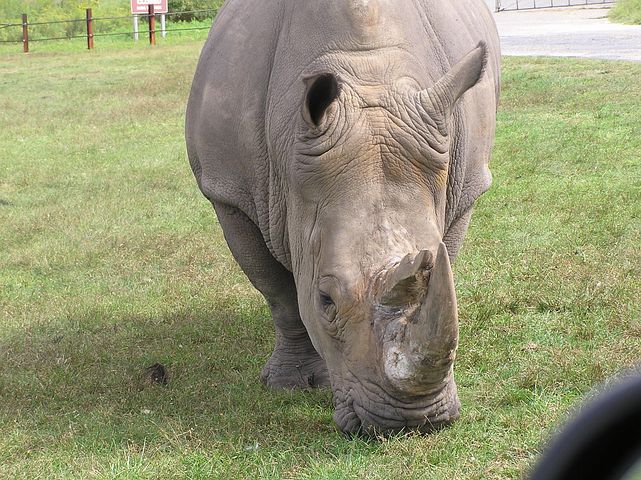When I think of a “Rhinoceros” it conjures up an image of a huge prehistoric beast, with a thick dry skin of armor and fiercly sharp prominent horn protruding from its head. Not surprising, considering they have roamed and inhabited the earth for 60 million years.
Sadly these days, all five species of rhinos are perilously close to extinction, prompting the introduction and urgent need of captive breeding programs.
The rate of their decline is truly astounding as between 1970 and 1980, half the world’s rhino population disappeared. Today, it is believed that there is an estimated 10,000 to 11,000 left worldwide.
In 1970, there were an estimated 65,000 black rhinos that could be found throughout Africa. However in eastern Africa, 90% of them were killed during the 70’s and now there are fewer than 2,500 left in the many pockets of Zimbabwe, South Africa, Kenya, Namibia and Tanzania.
Unlike most of our large mammals, who die due to habitat loss, this is not the case nor has it been a significant factor in the decline of rhinos. Poaching is the animal’s main threat to survival.
Looking back through history, as early as the 5th century BC, the rhino horn was believed capable of rendering some poisons harmless. People would kill a rhino for its tail, just to hang it in the room where a woman was giving birth, believing it would somehow ease her labour pains. Asians used the horn in traditional medicines for thousands of years without threatening the species survival. Enter the 1970’s. Young men in the Arab country of Yemen covert rhino horns for elaborately carved dagger handles, symbols of wealth and status. Until the 1970’s very few men could afford such a prized dagger handle. With the rise in oil prices, came a rise in wealth, and with a population of 6 million, became the world’s largest importer of rhino horn.
An adult rhino horn averages between 20 – 50 inches and is made up of millions of tightly compacted hairlike fibres.
Poachers can sell two horns on the black market for as much as $50,000. Just like elephant Ivory, a rhino’s horn is simply far to profitable for a poacher to resist.
Even though it is prohibited to trade in rhino horns, the ban hasn’t proved to be very successful, with illegal trade thriving on the black market.
Now that there are so few rhinos left, they are literally kept under armed guard in African Parks. During the day, they are allowed to forage and roam freely accompanied by guards with rifles, and at night they are locked up, under armed guard. Even though these extreme measures are taken to protect the few left, poachers have been known to kill guards to get at the rhino.
These professional poachers are driven by a desire for financial gain and sheer greed. This group sometimes involves experienced criminal gangs that are part of a more organized and structured group. Some believe that skilled professional hunters are also involved.
One tell tale sign is the fact that in some cases it is clear that the rhinos have been felled with one single well-placed shot to the head or body. The high-tech aerial attack will be done darting the animal from the air with tranquillizer guns.
It takes less than seven minutes to bring down the animal.
The fact that highly controlled and regulated veterinary drugs are used in certain cases of rhino poaching, indicates the involvement of professional veterinarians.
When they land the helicopter, they hack of the horns with a chainsaw. The use of a helicopter allows for easy access and quick getaways.
Several media reports have indicated that the registration numbers on the tail of the aircraft get covered up or falsified during the operation.
The rhino subsequently dies either from an overdose of tranquillizers or bleeds to death.
The rhinos are normally darted with a dosage of lethal drugs that may result in a quick death, although some evidence shows that the animal suffered great stress before death.
If the drug dosage had been too low to kill the rhino the animal is likely to wake during the brutal removal of the horns with a chainsaw.
The severely maimed rhino will then attempt to breath through a cavity in its nasal passage between its eyes. This rhino will have no sense of smell and if it survives will have a great battle to fight off any secondary infection.
Taronga Western Plains Zoo, Dubbo NSW, is one of a small number of zoos chosen globally by the “International Rhino Foundation” in 1992 to rapidly develop a conservation breeding program, for the various Rhinoceros species. The zoo is currently operating a very successful breeding program for three out of the five surviving species including the ‘Greater One Horned Rhino’, ‘The White Rhino’ and ‘The Black Rhino’.
Taronga has also been directly involved in supporting an Indonesian led program to save the Sumatran Rhino. There are only 100 or so of this breed left all held in captivity throughout the world.
Taronga can boast another success with the thriving health of a baby calf born only two weeks ago. The un-named calf is the forth born in the past 12 years to the zoo’s breeding program. At birth she weighed between 25 and 30 kilo’s, and as an adult could reach 900 kilos.
There are no immediate plans to place the new calf on view to the public as it is imperative right now that she have the time to bond and learn how to adapt to zoo life, from her mother.
For further information on the plight of the Rhinoceros or if you wish to make a donation, please check out the link below.


